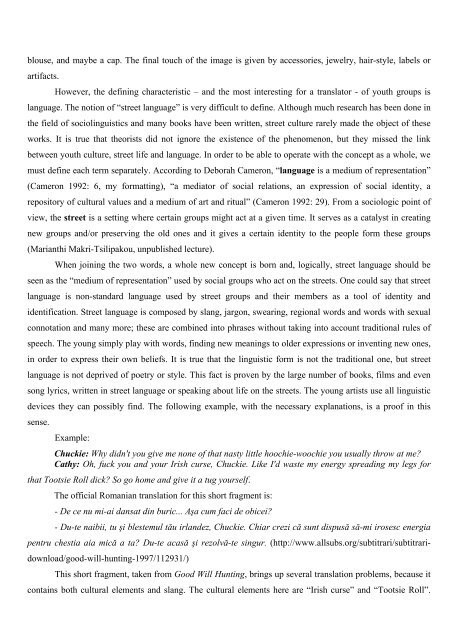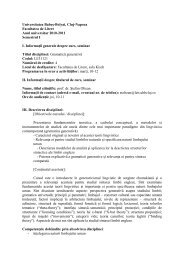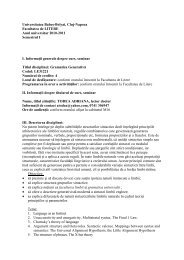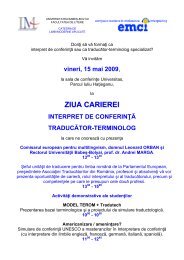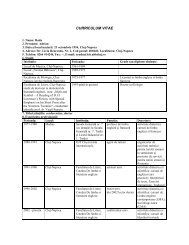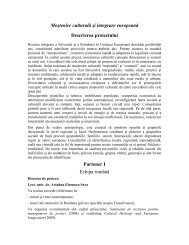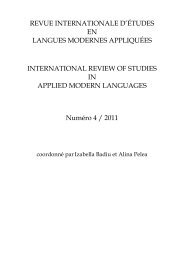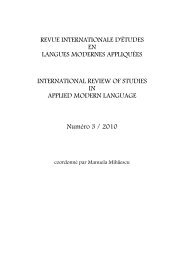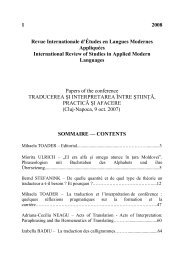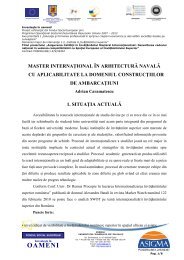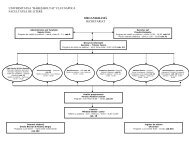Dimensiuni ale limbajului n context carceral
Dimensiuni ale limbajului n context carceral
Dimensiuni ale limbajului n context carceral
You also want an ePaper? Increase the reach of your titles
YUMPU automatically turns print PDFs into web optimized ePapers that Google loves.
louse, and maybe a cap. The final touch of the image is given by accessories, jewelry, hair-style, labels or<br />
artifacts.<br />
However, the defining characteristic – and the most interesting for a translator - of youth groups is<br />
language. The notion of “street language” is very difficult to define. Although much research has been done in<br />
the field of sociolinguistics and many books have been written, street culture rarely made the object of these<br />
works. It is true that theorists did not ignore the existence of the phenomenon, but they missed the link<br />
between youth culture, street life and language. In order to be able to operate with the concept as a whole, we<br />
must define each term separately. According to Deborah Cameron, “language is a medium of representation”<br />
(Cameron 1992: 6, my formatting), “a mediator of social relations, an expression of social identity, a<br />
repository of cultural values and a medium of art and ritual” (Cameron 1992: 29). From a sociologic point of<br />
view, the street is a setting where certain groups might act at a given time. It serves as a catalyst in creating<br />
new groups and/or preserving the old ones and it gives a certain identity to the people form these groups<br />
(Marianthi Makri-Tsilipakou, unpublished lecture).<br />
When joining the two words, a whole new concept is born and, logically, street language should be<br />
seen as the “medium of representation” used by social groups who act on the streets. One could say that street<br />
language is non-standard language used by street groups and their members as a tool of identity and<br />
identification. Street language is composed by slang, jargon, swearing, regional words and words with sexual<br />
connotation and many more; these are combined into phrases without taking into account traditional rules of<br />
speech. The young simply play with words, finding new meanings to older expressions or inventing new ones,<br />
in order to express their own beliefs. It is true that the linguistic form is not the traditional one, but street<br />
language is not deprived of poetry or style. This fact is proven by the large number of books, films and even<br />
song lyrics, written in street language or speaking about life on the streets. The young artists use all linguistic<br />
devices they can possibly find. The following example, with the necessary explanations, is a proof in this<br />
sense.<br />
Example:<br />
Chuckie: Why didn't you give me none of that nasty little hoochie-woochie you usually throw at me?<br />
Cathy: Oh, fuck you and your Irish curse, Chuckie. Like I'd waste my energy spreading my legs for<br />
that Tootsie Roll dick? So go home and give it a tug yourself.<br />
The official Romanian translation for this short fragment is:<br />
- De ce nu mi-ai dansat din buric... Aşa cum faci de obicei?<br />
- Du-te naibii, tu şi blestemul tău irlandez, Chuckie. Chiar crezi că sunt dispusă să-mi irosesc energia<br />
pentru chestia aia mică a ta? Du-te acasă şi rezolvă-te singur. (http://www.allsubs.org/subtitrari/subtitrari-<br />
download/good-will-hunting-1997/112931/)<br />
This short fragment, taken from Good Will Hunting, brings up several translation problems, because it<br />
contains both cultural elements and slang. The cultural elements here are “Irish curse” and “Tootsie Roll”.


